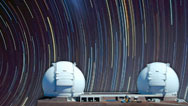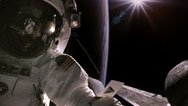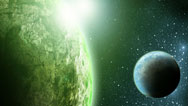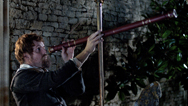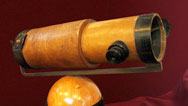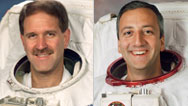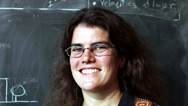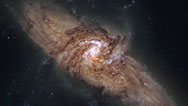
Hunting the Edge of Space: Hr 2
The Ever-Expanding Universe: Huge new telescopes are poised to penetrate the enigmas of dark matter and dark energy. Airing June 27, 2012 at 9 pm on PBS Aired June 27, 2012 on PBS
- Originally aired 04.13.10
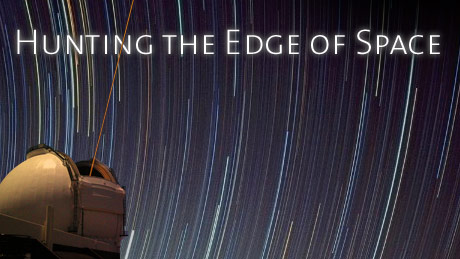
Program Description
Transcript
Hunting the Edge of Space: Hr 2
PBS Airdate: April 13, 2010
NARRATOR: Twenty years ago, NASA launched the Hubble space telescope, the first in a new generation of explorers to probe the edge of space. Today, a battery of high-tech telescopes is joining Hubble on its quest to unlock the secrets of our universe, a cosmos almost incomprehensible in its size, age and violence.
WENDY FREEDMAN (Carnegie Observatories): Telescopes have continued to open up vaster and vaster windows on the universe.
NARRATOR: As Hubble's journey draws to a close, scientists are racing to make new discoveries with telescopes that are bigger and more advanced than ever before.
MATT MOUNTAIN (Space Telescope Science Institute): Every time you try and explore a new part of the universe, we have these great discoveries, these great surprises.
NARRATOR: Since the start of the 20th century, telescopes have taken us beyond our planets and beyond our galaxy. Telescopes like Hubble have shown us things we never dreamed of: the very birth of our universe, invisible matter and the mystery of dark energy. Will the next generation solve the biggest question of all: our ultimate destiny?
KIM WEAVER (NASA Goddard Space Flight Center): Dark energy is one of the keys to understanding the fate, the ultimate fate of the universe.
NARRATOR: Hunting the Edge of Space, up now on NOVA.
At the dawn of the 20th century, our galaxy, the Milky Way, was the entire known universe, but now we live in the golden age of cosmic discovery. Telescopes are exploding our understanding of the cosmos. Bigger than ever and working in giant networks, across the globe and in space, they are unlocking secrets that astonish and amaze us: the planets of our solar system in breathtaking detail, the majestic rings of Saturn and rolling storm clouds on the surface of Jupiter.
But far beyond our solar system, we are now discovering exoplanets orbiting other suns, and beyond our galaxy, another hundred billion galaxies, like Andromeda, Sombrero and Whirlpool, each harboring hundreds of billions of stars. We've detected supermassive black holes, spinning violently at the very centers of galaxies, including our own.
We've witnessed supernovas: exploding stars, millions of light-years away, spewing out superheated gas at 600,000 miles per hour. And deep inside clouds of gas and dust, billowing trillions of miles high, we can glimpse new stars being born.
WENDY FREEDMAN: Telescopes have continued to open up vaster and vaster windows on the universe.
NARRATOR: Now, the latest telescopes are revealing the invisible mysteries of space that we are only just beginning to understand: dark matter, the hidden scaffolding our entire cosmos is built on; and dark energy, a powerful and invisible force that is pushing our universe apart.
MATT MOUNTAIN: Every time you try and explore a new part of the universe, we have these great discoveries, these great surprises.
NARRATOR: Back at the start of the 20th century the universe seems to be a much smaller place. The Sun, Earth and planets make up our solar system, and beyond them are the millions of stars that make up the rest of our galaxy, the Milky Way. But that's it. That is our universe. And for astronomers a major question remains.
GEOFF MARCY (University of California, Berkeley): A key question, at the beginning of the 20th century, was whether or not our Milky Way was all there was. Was that the whole universe, or were there other galaxies?
NARRATOR: So what happened? How did telescopes come to reveal so much of our cosmos and reach to its very edges?
The revolution starts in the early 1900s. A brand new telescope is being built. It will change our perception of the universe forever, explode the edges of the cosmos, and set us on a voyage of discovery that is still going on today.
ALEX FILIPPENKO (University of California, Berkeley): That telescope is one of the most important in the history of astronomy.
NARRATOR: The first steps in the revolution: an astronomer is hiking up Mount Wilson, a 5,700-foot peak, high above Pasadena, California. He's rising above the clouds and haze of the lower atmosphere, which distort telescopic images. He wants to see if it is possible to build an observatory at the very peak of the mountain, where the air is thin and crystal clear.
ROBERT SMITH (University of Alberta): There was a growing realization that, for really good astronomical seeing, you had to find good sites, rather than just build a telescope where you happen to have an old observatory. People had begun to realize that the mountains in the west of the United States offered real possibilities.
NARRATOR: One hundred years ago, the simple idea of putting an observatory on top of a mountain is revolutionary and an enormous logistical challenge. Hundreds of tons of steel and concrete have to be carefully hauled up the narrow mountain roads, but the clear skies are worth it. Mount Wilson will become the highest observatory on Earth and a blueprint for observatories all over the world.
This observatory is the vision of one man, George Ellery Hale. His mission: to solve the greatest mysteries in the cosmos to find out if there is anything beyond our galaxy.
But for Hale, high altitude is just the first step. To see deep into the cosmos, with stunning clarity, he needs his new observatory to house the biggest telescope in the world. Telescopes are like light buckets: the larger the telescope, the more light it can gather, bringing the faintest stars into focus.
But Hale faces a challenge. Most telescopes at the time use glass lenses to focus light. But when glass lenses get really big, they bend under their own weight, causing distortion. Glass lenses just can't get any bigger.
What Hale needs is a radical new design: a giant telescope that can collect a lot of light but which doesn't use lenses. So Hale turns to a telescope first created by Isaac Newton in 1668: the reflector.
This kind of telescope uses a curved mirror instead of glass lenses. It focuses light by reflecting it to a point. Now, Hale is planning to build one on a scale that has never been seen before. Only revolutionary engineering can support the gigantic instrument he plans.
And the project will take 11 years to complete. The curved mirror spans 100 inches in diameter, and weighs 9,000 pounds. It sits at the bottom of a 40-foot cast iron tube housed in a 100-foot diameter dome.
Finally, in 1917, the biggest telescope the world has ever seen sparks wonder amongst the public.
NEWSREEL NARRATOR (Film Clip): The scientific eye of America: to this mecca of stargazers, flock astronomers from all nations.
WENDY FREEDMAN: In the pantheon of the telescopes in astronomy, Mount Wilson, it is no exaggeration to say, is probably the most important telescope in the history of cosmology.
ROBERT SMITH: Discoveries that were made here really put it onto the map.
NARRATOR: This great telescope is soon directed towards one of astronomy's most enduring mysteries. Strange, fuzzy clouds of light hanging amongst the stars have puzzled astronomers for years. They are the nebulae.
Some are egg-shaped swirls; others are delicate spirals of stars; others have branching tentacles. Thousands of them are visible through telescopes, but nobody knows what they are, or how far away they are.
Some astronomers believe that certain types of nebulae could lie outside the edges of our Milky Way galaxy. They wonder if they could be island universes, galaxies like our own. If so, this would shatter the limits of the universe and our understanding of it. But they have never had the technology to solve the mystery, until now.
Hale invites the world's best astronomers to help crack the mystery once and for all. Among them is a young man called Edwin Hubble.
ALEX FILIPPENKO: Edwin Hubble was one of the greatest observational astronomers ever to have lived. He made a tremendous number of important discoveries.
NARRATOR: Night after night, Hubble examines the nebulae with the 100-inch telescope. He examines one in particular: the Andromeda nebula, which Hubble can now see in unprecedented detail.
MICHAEL TURNER (University of Chicago): It would be this hundred-inch telescope that would finally be powerful enough to bring the nebulae within reach and would start a series of discoveries that just completely changed, uh, our understanding of the universe.
NARRATOR: Hubble can see stars within the Andromeda nebula, but to find out if it really is an island universe outside the Milky Way, he has to find out how far away it is. But that is not an easy task. Establishing distances in the vastness of space is one of astronomers' biggest challenges.
Stars, like car headlights, appear brighter the closer they are. If you know their true brightness, you can work out their distance. It's like knowing the wattage of a lightbulb. If you don't know this, you have a problem, as NASA astrophysicist Kim Weaver explains.
KIM WEAVER: At that distance, the headlight on that car appears to be the same brightness as the headlamp on this bicycle.
NARRATOR: But as the headlights get nearer, it becomes obvious that their true brightness is, in fact, greater than that of the bicycle lamp. It's the same with stars.
KIM WEAVER: If we know how bright a star is, intrinsically, we can work out how far away it is from us. And that's what we call a "standard candle."
NARRATOR: Luckily for Hubble, astronomers had recently discovered a special type of star, with a true brightness they can calculate. It is called a Cepheid variable, and it's recognizable because it pulsates over a period of days.
All Hubble has to do now is find one of these stars in a nebula like Andromeda. At night, he scans the heavens with the 100-inch mirror. By day, he analyzes the photographs he has taken, hunting for any stars that have changed brightness.
Then, on October 6, 1923, after months of work, Hubble strikes gold: a Cepheid variable on the edge of Andromeda.
WENDY FREEDMAN: I'm looking at the original discovery plate of Edwin Hubble's, where he first found a Cepheid in the Andromeda galaxy. And he actually marks on this plate, between two black lines, where the position of the Cepheid. And he writes "Var!," when he realizes it's a Cepheid. So he's compared two different plates, and he's discovered that this thing is actually changing in its brightness.
NARRATOR: Hubble can now make a measurement that will change history: the distance to one of the nebulae. He works out that Andromeda is about 800,000 light-years away. That's more than eight times the distance to the furthest known stars in the Milky Way. This means Andromeda has to be outside the Milky Way, a whole new galaxy beyond our own.
WENDY FREEDMAN: This is irrefutable evidence. He's very excited. He writes it with an exclamation mark, because he realizes the significance of the discovery.
NARRATOR: Hubble's discovery explodes the frontiers of our universe. Our Milky Way galaxy is no longer all there is in the cosmos. Hubble goes on to discover that Andromeda is not alone. He reveals that dozens of nebulae are actually other galaxies.
ALEX FILIPPENKO: Edwin Hubble's research with telescopes profoundly changed our view of the universe.
NARRATOR: The most powerful telescopes of today are still exploring the wider cosmos that Hubble first discovered. Looking across billions of light-years they have uncovered 100 billion new galaxies, beyond our own, each made up of 100 billion stars. Multiply those together and you have more stars than all the grains of sand on all the beaches and all the deserts on Earth.
MICHAEL TURNER: Just like that, the universe became a hundred billion times larger.
NARRATOR: Hubble's discovery that there were other galaxies outside our own blows the universe wide open. But what he discovers next will be even more extraordinary.
Several years earlier, other astronomers had discovered that many of the nebulae, now identified by Hubble as galaxies, were moving away from us. Now Hubble wants to work out why, and he will do it by analyzing light itself. He uses a method first discovered in the 1800s.
JIM BENNETT (University of Oxford): This is a spectroscope, made in about 1880, one of the first generation of instruments used for analyzing the light from the Sun. It's an instrument like this that transformed astronomy, because you can decode the light in a way that you'd never imagined.
NARRATOR: The spectroscope splits white light into its rainbow spectrum of colors, and hidden in this spectrum are clues to the behavior of the stars.
Light is made up of waves. And each color has its own wavelength. Blue light has a short wavelength; red light has a longer wavelength. But when a galaxy is racing through the cosmos, the wavelengths of light appear to change, from our perspective on Earth. If the galaxy is moving towards us, the wavelengths get squashed and appear more blue. If the galaxy is moving away from us the wavelengths get stretched out and appear to become more red.
We call the effect "redshift." It's like a cosmic speedometer. The faster a galaxy is moving away from us, the more its light waves are stretched towards the red. Sound works in much the same way, because it, too, is made up of waves, as astronomer Alex Filippenko explains.
ALEX FILIPPENKO: Ah, this is going to be great. I'm going to blare on the horn now. Here we go.
[Horn]
The pitch of the sound is constant, even though the car is speeding down the road.
NARRATOR: In the driver's seat, Filippenko hears the horn at a constant pitch. It doesn't change. But now he wants to hear what the horn will sound like if he stands on the roadside and the car drives past him.
[Horn]
ALEX FILIPPENKO: When the car was coming towards me, the waves from the horn were being squished together so the pitch sounded higher. As the car came past and moved away, the waves were stretched apart so the pitch sounded lower. So it sort of went "nrrreeeoiii." If that blue car had been going fast enough, then the high frequency blue light would have been stretched apart, then the blue color would have shifted all the way to red. The car would have looked red to me.
NARRATOR: Back in 1928, Hubble is looking at the redshift of his new galaxies, to find out how fast they are moving. He sets out to chart the speeds of galaxies both near and far. He wants to see if he can find any correlation between how fast they're moving and how far away they are.
Night after night is spent painstakingly analyzing the light from galaxies. The final results are staggering. Hubble discovers that the farther away a galaxy is, the greater its redshift, so the faster it is moving away.
MICHAEL TURNER: By 1929, he had established a very interesting relationship between them: the nebulae that are farther away are moving faster away.
NARRATOR: Hubble comes to an astounding conclusion: the universe is expanding. The galaxies may look like they are traveling away from us, but, in fact, it is space itself that is stretching apart.
ALEX FILIPPENKO: Here's a good analogy of how the expanding universe works. Now this is a hypothetical, one-dimensional universe, where the ping-pong balls are the galaxies and the hose is the space between them. As the space expands, all the ping-pong balls recede away from one another, and every bit of space expands. The more space there is, the faster the distant one looks like it's expanding away from us.
NARRATOR: Hubble's discovery is one of the greatest breakthroughs in the history of astronomy: the universe is not static, it is growing bigger and bigger.
ALEX FILIPPENKO: These galaxies are moving apart from one another because space itself is expanding between the galaxies. That was a marvelous discovery.
NARRATOR: Hubble could never have made his discoveries without the 100-inch telescope on Mount Wilson. High above the plains of New Mexico, one of the most advanced telescopes of today is taking Hubble's groundbreaking work even further.
The Sloan Digital Sky Survey is analyzing starlight from hundreds of thousands of distant galaxies. Each aluminum disk is a galaxy map for a small part of the night sky.
STEPHANIE SNEDDEN (Apache Point Observatory): So, we've got 640 holes on an aluminum plate. Each hole corresponds to a galaxy, many, many, many, many millions of light-years away.
NARRATOR: Optic fibers link each hole to a high-tech version of the spectroscope used by Edwin Hubble. It will measure the redshift of the galaxies. Then, technicians insert the map into the base of the telescope and match it up to the right section of the night sky.
STEPHANIE SNEDDEN: So you can get 640 spectra at once, which is a great way to get a survey done, much better than once at a time.
NARRATOR: This survey has now calculated the speeds of over 930,000 galaxies, giving us a far more precise image of the universe we live in and how fast it is racing apart. But back in 1929, Hubble's discovery begs a new question: if the universe is expanding, what is it expanding from?
KIM WEAVER: Hubble saw and realized that things were moving away from each other and the natural leap from that is, "Well, if things are now moving away, weren't they all, at some time, in a central location?"
NARRATOR: Astronomers put forward a revolutionary theory: the Big Bang, a single moment in time when the universe was born. The idea is so revolutionary, scientists struggle to make sense of it.
KIM WEAVER: We had no way to observe this phenomenon. It made no sense to people at the time. Even Einstein didn't believe in this idea. We didn't have the belief that it might happen, and we also didn't have the telescopes to observe the effects of the Big Bang.
NARRATOR: To find the proof, astronomers will need a completely different type of telescope, one that can see what our eyes cannot. Beyond the colors of visible light, are the rays of the electromagnetic spectrum that our eyes cannot detect. Gamma rays, X-rays, radio waves and microwaves may be invisible, but they are crucial for astronomers. They hold the keys to some of the most violent events in the universe.
MARIO LIVIO (Space Telescope Science Institute): The human eye is only sensitive to a very small part of the electromagnetic spectrum; these are all the waves that behave like light. But we have been able to see in parts of the spectrum which are not visible to the human eye.
NARRATOR: 1964: astronomers Arno Penzias and Robert Wilson are working with a new radio telescope. Its giant antenna enables them to measure microwaves and radiowaves in space in the form of heat. They expect the stars of our Milky Way to emit a faint glow, but when they point their antenna to empty space, where there should be nothing at all, they discover something very unusual.
ARNO PENZIAS (Nobel Laureate in Physics): We expected to find the sky away from the Milky Way to be quite cold, I mean very close to absolute zero. Instead, we found, to our very great surprise, that it was about three degrees hotter than that.
NARRATOR: The mysterious signal seems to come from every direction.
ARNO PENZIAS: We had a noise, a signal, if you can call it that. It could be radio noise sources or something else. I had no idea what it was.
NARRATOR: Penzias and Wilson suspect that there is a defect with the equipment, which is causing interference. They try everything, even sweeping the pigeon droppings from inside the antenna.
ARNO PENZIAS: It didn't go away through winter or summer, day to night, seasons. We looked at every possible direction. There was a high altitude nuclear explosion two summers ago, so there was something in the atmosphere? Charged particles? I didn't know.
NARRATOR: Penzias and Wilson are at a loss, until they hear about the work being carried out by a team of scientists, just down the road, at Princeton University. Robert Dickie and his colleagues have worked out that the afterglow from the Big Bang should still be felt today. They have even calculated the temperature: three degrees above absolute zero.
ARNO PENZIAS: So I called up, and I happened to get him. And what I learned, afterwards, was that he put down the phone, and he turned to his colleagues, and he said, "Boys, we've been scooped."
NARRATOR: Penzias and Wilson have unwittingly found the first physical evidence of the Big Bang. Their radio telescope has picked up the afterglow of the beginning of the universe. It remains one of the most important discoveries of all time.
ARNO PENZIAS: I had no idea that we were listening to the echo of creation.
NARRATOR: In 1978, Penzias and Wilson received the Nobel Prize.
ARNO PENZIAS: To be on a list with Albert Einstein, to be on that same roll, was almost too much, too much to bear. I just couldn't think of comparing myself against the people who have won Nobel Prizes.
WENDY FREEDMAN: In 1964, when the background radiation from the Big Bang was discovered, it was, for the first time, direct evidence that there was a hot Big Bang, an origin to the universe.
NARRATOR: Penzias and Wilson have found direct proof for the Big Bang, but it will take another 37 years and far more sophisticated microwave technology, before we discover how the Big Bang formed the universe we see today.
Heading to an orbit, 1,000,000 miles from Earth, is the Wilkinson Microwave Anisotropy Probe, or WMAP, a super-advanced version of Penzias and Wilson's giant antenna, armed with two reflecting telescopes.
WMAP's mission is to examine the afterglow of the Big Bang in extreme detail and to try and find out why galaxies formed.
CHARLES BENNETT (Johns Hopkins University): With WMAP we were trying to look way back to the very, very earliest times in the universe.
NARRATOR: After a year of recording, the first results are mapped.
WENDY FREEDMAN: The WMAP observations were incredible. Instead of a smooth background radiation, you could measure to 1,000th-of-one-percent changes in the temperature, across the sky.
NARRATOR: WMAP shows that, actually, there are tiny fluctuations in temperature.
CHUCK BENNETT: The dramatic-looking temperature changes, here, are actually tiny. Going from a redder hot spot, here, to a bluer cold spot is only a change of a couple of millionths of a degree. So it's really only tiny temperature changes but a really dramatic pattern over the sky which has revealed tremendous information to us.
NARRATOR: The tiny red spots are where matter is beginning to come together and where clusters of galaxies will eventually form. This is vital evidence, clues to how stars and galaxies first came into being. The WMAP data helps astronomers work out what happened at the very beginning of the universe, right after the Big Bang.
CHUCK BENNETT: We can actually deduce from that, things that happened in the first trillionth of a trillionth of a second of the universe. I think that's just extraordinary, to be able to probe that early in the history of the universe.
NARRATOR: And WMAP's accuracy allows astronomers to solve another great cosmic mystery: the exact age of the universe. For the first time, astronomers have an accurate figure.
ALEX FILIPPENKO: We now know that universe is about 13.7-billion years old. That's very old, but it's not infinite. It could have been infinite, but it's not—one of the great discoveries of 20th century science.
NARRATOR: WMAP has taken us further from the Earth and closer to the very birth of the cosmos than any other telescope in history. It is revealing the edges of the universe in unprecedented detail. But the microwave data it records is invisible to the human eye. Would it ever be possible to see the very first galaxies in the universe in ordinary, visible light? Only if optical telescopes also take a giant leap in technology and head for the skies.
NASA MISSION CONTROL: Liftoff of the space shuttle Discovery, with the Hubble space telescope, our window on the universe.
NARRATOR: NASA launches the most famous telescope ever built.
MARIO LIVIO: If you ask any person on the street to name a telescope, they will say the Hubble space telescope.
MATT MOUNTAIN: The Hubble space telescope is probably the most productive telescope in history. It has been compared to the time when Galileo lifted his telescope to the sky for the very first time.
NARRATOR: The 12-ton Hubble space telescope is a fitting tribute to the man who first took us beyond the edges of our galaxy. It bursts through Earth's atmosphere and is released into orbit, 370 miles above us.
Ever since Hale built his observatory on a mountaintop, astronomers have dreamt of having a telescope in space. Here, far above the interference of the Earth's atmosphere, there's no haze, smog or cloud to obscure the light streaming in from the universe.
MATT MOUNTAIN: Putting a telescope in space gives us an incredibly clear view of the universe. We have seen further and deeper into space than any other telescope in history.
NARRATOR: And Hubble is looking at light that is visible.
MATT MOUNTAIN: What we're able to do with Hubble is essentially capture the images as though you had two-meter eyes, and you were in a vacuum, and you could hold them open for a week. This is what you would see. They're not computer creations. They're actually digital pictures that you can actually see.
NARRATOR: The crystal-clear images taken by Hubble are some of the most extraordinary visions of space ever seen: the remains of exploding stars, streaming through space; vast clouds of gas and dust, where new stars are being born; distant galaxies, spiraling in giant disks and colliding to create super galaxies.
MATT MOUNTAIN: My favorite image, I think, must be the Butterfly nebula. It's a nebula that has gas streaming out at 600,000 miles an hour.
Telescopes are time machines. We're seeing photons that actually started their journey 13-billion years ago and have taken that long to traverse interstellar space to us. And so you're not only looking out into space, you're looking back in time.
NARRATOR: In 1995, Hubble's ability to look back in time is put to the test. Astronomers decide to turn its gaze onto one dark point in the universe, just to find out what they can see.
MARIO LIVIO: We picked one tiny point in the sky, in which there was, essentially, nothing there.
MATT MOUNTAIN: We stared, for 10 days, at a single dark spot on the sky.
NARRATOR: It is as if Hubble was peering through a tiny keyhole of our Milky Way galaxy, to the universe beyond.
MATT MOUNTAIN: The size of the spot that we looked through was no more than a drinking straw.
NARRATOR: What Hubble sees is extraordinary.
MATT MOUNTAIN: And what we saw were 10, 000 galaxies in that single spot.
MARIO LIVIO: Every point of light that you see in the image represents a galaxy with a hundred billion stars like the Sun.
NARRATOR: The image is called the Hubble Deep Field. It shows light from galaxies four-billion times fainter than anything we can see with the human eye, light that set out on its journey billions of years ago.
MARIO LIVIO: If there is something to give you a sense of the size of the universe and its depth, it's this kind of image.
NARRATOR: Every time the Hubble space telescope has been serviced by astronauts, the camera has been upgraded. After NASA's final mission, in 2009, a new Deep Field image reveals the furthest galaxies ever seen, only 600-million years after the Big Bang.
MICHAEL TURNER: We're seeing back as far as we can see, because we're seeing back to the time of the birth of the galaxies.
NARRATOR: The Hubble space telescope is taking images that continue to amaze us.
MARIO LIVIO: I believe that the Hubble space telescope, in some sense, has been really unique in the history of science. It has taken, really, the excitement of discovery and has made it, you know, to belong to every home, to humans all across the globe.
NARRATOR: Hubble has revealed the mysteries of our cosmos in stunning glory. Now it is working within a vast network of modern super telescopes to investigate a discovery that has rocked the world of astronomy, a discovery that threatens to turn everything we thought we knew about the universe on its head, an enigmatic force called "dark energy."
MICHAEL TURNER: Dark energy is the most mysterious thing we have ever discovered.
MATT MOUNTAIN: It is an energy which came out of nothing, out of the vacuum. But we have no idea what it is.
NARRATOR: Dark energy's discovery came as a complete surprise. In the mid-1990s on Mauna Kea, Hawaii, at the Keck Observatory, a team of astronomers, including Alex Filippenko, is scouring the distant cosmos. They know the universe has been expanding, but will it really expand forever? They have a theory: the universe might actually stop expanding and start slowing down.
ALEX FILIPPENKO: Just like when I throw this apple in the air, the gravitational attraction of the Earth on the apple slows it and eventually stops it and reverses its motion. So, too, all the galaxies pulling each other could slow down the expansion of the universe, ultimately stop it and then reverse it into a big crunch.
NARRATOR: So is the universe really beginning to fall back in on itself?
To measure the speed of the very edges of space, astronomers need the most powerful telescopes on Earth.
The giant mirrors of the Keck telescopes are 33 feet in diameter, made, not from one single disk of glass, but 36 hexagonal mirrors, working together. They give a single image of exceptional clarity.
ALEX FILIPPENKO: The Keck telescopes are really fantastic devices. They can allow us to see galaxies that are literally at the edge of the visible universe, 10-, 11-, 12-billion light-years away.
NARRATOR: But to find out how far away these distant galaxies actually are, astronomers need a standard candle, a star that will act as a cosmic yardstick. But the Cepheid variable stars that Edwin Hubble used are too faint at the extremities of the cosmos. The astronomers need to hunt for an especially bright kind of star inside the furthest galaxies. The deaths of these stars cause some of the most devastating explosions known to humankind. They are called supernovae.
ALEX FILIPPENKO: A supernova is, quite literally, an exploding star. Now, most stars don't explode at the end of their lives, but a few completely disrupt themselves in a colossal, titanic explosion.
NARRATOR: And not just any type of exploding star will do. They are looking for a type of supernova that explodes with a very intense and consistent brightness: a type 1a.
ALEX FILIPPENKO: They go off like a gigantic nuclear runaway. They are essentially a gigantic nuclear bomb.
NARRATOR: In the most distant galaxies of the universe, they find what they are looking for: type 1a supernovae.
ALEX FILIPPENKO: There it is there it is. Look at that! It's a little bit fuzzy.
NARRATOR: Now they measure the redshift to calculate how fast these distant galaxies are moving away.
Finally, in 1998, after years of research, they come to a shocking conclusion: the expansion of the universe isn't slowing down at all; it's speeding up.
ALEX FILIPPENKO: Much to our surprise, we found that the universe is expanding faster now than it used to be. Instead of slowing down, it's speeding up. So it's like the apple goes "zzzzoom," like that—a completely fantastic conclusion.
NARRATOR: A mysterious force that no one can see is defying gravity, pushing the universe apart faster than ever. It is the force astronomers now call dark energy.
WENDY FREEDMAN: There is the possibility that Einstein's gravity is incomplete, that we don't understand gravity. There is the possibility that it could change some of the fundamental laws of physics.
NARRATOR: But what dark energy actually is and what it will do to our universe remains a mystery, to this day.
KIM WEAVER: Dark energy is one of the keys to understanding the fate, the ultimate fate of the universe. Is it going to expand forever?
MICHAEL TURNER: Will it continue to speed up? Will the speed-up speed up, in which case, the universe gets ripped apart?
NARRATOR: The one thing astronomers do know is that dark energy makes up most of the universe.
MARIO LIVIO: We discovered, since, that this dark energy is some 72 percent of the energy density of our universe, and, yet, we don't know what it is. I mean, just so that you understand the level of the puzzle: about 70 percent of the surface of the Earth is covered with water; imagine we didn't have a clue what, what water was. This is the situation we're in.
NARRATOR: As if one invisible mystery isn't enough, scientists at NASA's Jet Propulsion Lab are investigating an equally mysterious invisible substance: dark matter.
JASON RHODES (NASA Jet Propulsion Laboratory): Dark matter is basically invisible. We can only see it by looking at how it distorts things that are behind the dark matter.
NARRATOR: Images taken by the Hubble space telescope are now helping to reveal where dark matter can be found in the universe. Hubble's images show that this invisible substance is bending light.
JASON RHODES: A good analogy is a pool of water. If you went out and threw a penny to the bottom of the pool, you would look down at that penny and you would see that penny very clearly, because the light from the penny is coming through the water. The water is essentially invisible, but the shape of that penny is distorted because that light travels, not a straight path, but a slightly curvy path through the water, to come to our eye.
NARRATOR: Dark matter has a similar effect. It exerts a powerful gravitational pull on light from distant galaxies.
JASON RHODES: So what we're looking at, here, is light coming to us through the dark matter distribution. And as the light goes through the dark matter distribution, the path of the light is bent.
NARRATOR: Astronomers calculate that dark matter makes up 23 percent of the universe. Add that to dark energy and that leaves just five percent of the entire universe that is not invisible. So, after 400 years of searching the heavens with telescopes, we still have 95 percent of the universe to reveal, and a new quest is beginning.
A new generation of telescopes—millions of miles in space, high on mountaintops and deep below the Earth—is gearing up to change our understanding once again.
MATT MOUNTAIN: Telescopes are at the forefront of changing the way we think of the universe, because it's the only way to see the universe.
WENDY FREEDMAN: So these big, giant new telescopes we're trying to build now are trying to answer some fundamental questions: what's the nature of the universe we live in? What is the stuff that makes up the universe? Could there be life elsewhere in the universe?
NARRATOR: The most sensitive scientific instruments today are not just looking at detectable light; they are searching for the invisible, and they will reveal mysteries of the cosmos beyond our wildest dreams.
KIM WEAVER: There's a whole hidden universe out there, and that's what we're trying to discover.
NARRATOR: Since the time when telescopes were first raised towards the heavens, we have been hunting the edges of the universe. Revolutions in technology and the race to build bigger, higher and even in space, have given us discoveries that have been revelatory, earth-shattering and profound.
GEOFF MARCY: We now know how little we are, compared to the extraordinary size of our universe.
NARRATOR: We are even on the brink of discovering planets with the building blocks for life.
WENDY FREEDMAN: Are there Earth-like planets? Could there be life elsewhere in the universe? One of the exciting things about these big telescopes: they're very likely to give us the answers to these questions.
NARRATOR: At each stage, we have pushed the boundaries of our universe further, beyond our planets, beyond our galaxy, beyond the hundred billion other galaxies, and virtually back to the Big Bang and the beginning of time. Telescopes are changing everything we thought we knew about our tiny planet and its true place within the cosmos. Who knows what they will reveal in the future?
MATT MOUNTAIN: We're going to look back. In another 100 years, I think, the whole world and our view of it will be transformed yet again.
Broadcast Credits
Hunting the Edge of Space: Hr 2
- Directed by
- Oliver Twinch
Peter Jones - Telescript by
- Oliver Twinch
David Axelrod - Story by
- Peter Jones
Richard Hudson
David Axelrod - Executive Producers
- Kate Botting
Richard Hudson - Produced by
- Oliver Twinch
David Axelrod - Co-Producer
- Paul Burgess
- Narrated by
- Jay O. Sanders
- Associate Producer
- Calum Walker
- Cast
- Duncan Bonner
Dan Maxwell
Steven Deproost
Chloe Lucas
Andrew Morris
Sam Spurgeon
Martin Whatley
Dan Winter - Edited by
- Mairin O'Faolain
Paul Burgess
Robert Hutchings
Dan Wolfmeyer
Nigel Ashcroft - Audio Mix
- Mitch Griffin
- Camera
- Brian McDairmant
Michael Phillips
Frazer Bradshaw
Simon Fanthorpe
Erich Roland - Assistant Camera
- Steven Cassidy
- Sound Recordists
- Joe Demko
Dwayne Dell
Lisa K. Johnson
Keith Rodgerson - Music
- Joel Douek
Greg Pliska - Animation
- Fluid Pictures Limited
Minnesota Planetarium Society - Senior Production Manager
- Jennie Reedquist
- Production Managers
- Carrie Pennifer
Fiona Marsh
Carey Ann Strelecki - Production Coordinators
- Andy Zare
Elena Wong
Leanne Hemmings - Art Director
- Sam Pine
- Location Managers
- Sam Spurgeon (UK)
Gabriella Belloni (Italy) - Researchers
- Doug French
Anne Lillburn - Costume Dressers
- Jacqui Jones
Mark Foster
Jill Blundell - Hair/Make Up
- Lori Lee
- Make Up Assistant
- Colin Wyatt
Valerie Hetherington - Specialist Props
- Michael Tucker
Ian Humphries - Painter
- Helen Shackleton
- Carpenter
- John Tinney
- Smoke and Wind
- Mark Turner
- Lighting
-
Colin Holloway
Gary Owen - Lighting Tower
- John Hudson
- Assistant Director
- Tony Sherborne
- Researchers
-
Doug French
Anne Lillburn
Victoria Stable
Valerie Heatherington
Hugo Mander - Post Production Producer
- Ted Hinck
- Senior Operations Manager
- Robert Sturm
- Colorist
- Robert Hutchings
- Post Production Online Editor
- Ezra Gold
- Assistant Editor
- Edward Harber
- Assistant Producers
- Imogen Haigh
Cully Gallagher
Stephanie Mosher - Consultants
- Albert Van Helden
Richard Tresch Feinberg
Steve Maran
Lawrence Rudnick
William Sheehan
Joel Halvorson
Paul Murdin - Archival Material
- AIP Emilio Segrè Visual Archives
ALMA (ESO/NAOJ/NRAO)
Caltech Archives
Carnegie Observatories
Dastoli/Pond5
David Rose Collection
ESA
ESA/HUBBLE
ESO
Gemini Observatory
Getty Images
Giant Magellan Telescope - Carnegie Observatories
Goddard SpaceCenter/NASA
Huntington Library
IMSS, Florence, Italy
Interstellar Studios
Kirk Pu'uohau-Pummill/Gemini Observatory
Larry Webster Collection
Linda Hall Library of Science, Engineering & Technology
Margaret Harwood/AIP/ESVA
Mason Productions Inc.
Max Planck Society
NASA
NASA/HUBBLE
NASA/JPL
NASA/JPL/SSI
NASA/STScI
National Library, Florence, Italy
National Radio Astronomy Observatory/NASA
NOAO
Paris Observatory
Science Photo Library
Simon Carroll Archive
University of Wisconsin
W.M Keck Observatory - Special Thanks
- All Saints Church, Easter Compton, England
American Astronomical Society
Apache Point Observatory, New Mexico
Birr Castle Demesne, Ireland
Bristol University & Foundry
California Institute of Technology
Carnegie Observatories
Church Farm, Easter Compton, England
City of San Jose
Erik le Groen
Herschel Museum, Bath, England
Iford Manor, Wiltshire, England
Institute and Museum of the History of Science, Florence, Italy
Institute of Astronomy, Cambridge
Johns Hopkins University
Large Binocular Telescope Observatory, Arizona
Michael Brett
Michael Tabb
NASA/JPL
National Academy of Sciences
Orion Telescopes
Pamela Gay, Southern Illinois University
Royal Observatory Greenwich
Smithsonian Institution, National Air and Space Museum
Space Telescope Science Institute
The Harvard Smithsonian Center for Astrophysics
The Museum of the History of Science, Oxford
University of Arizona, Steward Observatory Mirror Laboratory
University of CA, Berkeley
William Parsons, 7th Earl of Rosse
Yerkes Observatory - Head of Production, Brook Lapping
- Andrew Mckerlie
- Vice President of Program Production, TPT
- Gerald Richman
- NOVA Series Graphics
- yU + co.
- NOVA Theme Music
- Walter Werzowa
John Luker
Musikvergnuegen, Inc. - Additional NOVA Theme Music
- Ray Loring
Rob Morsberger - Closed Captioning
- Armour Captioning
- Publicity
- Carole McFall
Eileen Campion
Victoria Louie
Karen Laverty - Marketing
- Steve Sears
- Researcher
- Kate Becker
- Production Coordinator
- Linda Callahan
- Paralegal
- Sarah Erlandson
- Talent Relations
- Scott Kardel, Esq.
Janice Flood - Legal Counsel
- Susan Rosen
- Production Assistant
- Ryan Murdock
- Post Production Assistant
- Darcy Forlenza
- Associate Producer, Post Production
- Patrick Carey
- Post Production Supervisor
- Regina O'Toole
- Post Production Editor
- Rebecca Nieto
- Post Production Manager
- Nathan Gunner
- Compliance Manager
- Linzy Emery
- Development Producer
- Pamela Rosenstein
- Supervising Producer
- Stephen Sweigart
- Business Manager
- Joseph P. Tracy
- Senior Producer and Project Director
- Lisa Mirowitz
- Coordinating Producer
- Laurie Cahalane
- Senior Science Editor
- Evan Hadingham
- Senior Series Producer
- Melanie Wallace
- Executive Producer
- Howard Swartz
- Managing Director
- Alan Ritsko
- Senior Executive Producer
- Paula S. Apsell
A NOVA production by Brook Lapping Productions and TPT National Productions, in association with Green Umbrella Films, LLC
© 2010 WGBH Educational Foundation and Twin Cities Public Television, Inc. All Rights Reserved
- Image credit: (star trails) Courtesy Elke Shulz/NASA; (Keck Interferometer) Courtesy NASA/JPL
Participants
- Almaz
- 20 years old
- Ana Mari & Clotilde
- Ayehu
- 25 years old
- Barbara
- Beth Van de Bussche
- Concepcion & Patricia
- Evan Johnson & Jeffrey Grattan
- Westmont High School westmont.cuhsd.org/
- Fikre
- Ayehu's friend
- Lee
- Physicist: von Braun Team
- Moby
- www.moby.com/biography
- Paul
- Ramilisonina
- Archeologist
- Stewart
- Environmentalist and Author
- Susan
- Wubete
- 17 years old
- John Abbey
- Collavino Construction
- Mohamed Abd-el-Maguid
- Underwater Archeologist www.underwaterdiscovery.org/Sitemap/Homepage/AboutUs/CommonShowTeamMember.aspx?&XmlDocument=0118.xml
- Ralph Abraham
- University of California, Santa Cruz www.math.ucsc.edu/Faculty/abraham.html
- LT. Gen. James Abrahamson
- MOL Crew Member
- Matthew Abrams
- StarClimber
- John Guilmartin
- Military Historian www.angelfire.com/ga4/guilmartin.com/
Preview | 00:30
Full Program
Full program available for streaming through
Watch Online
Full program available
Soon

